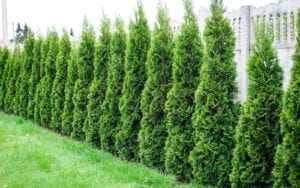
While we are all social creatures by nature, we tend to enjoy our privacy just a little bit more… especially when it comes to our own back yard. The old saying “good fences make for good neighbors” definitely applies here, but a living screen of beautiful trees and shrubs is far more appealing to the eye than any fence could ever be. With a cornucopia of plant choices available, utilizing trees and shrubs for screening could potentially be a daunting task. The following will assist any novice or seasoned gardener make the best choices.
Whether your screen of plants is for privacy, creating boundaries, or just blocking an undesirable view, simple, yet careful planning and preparation will organize your thoughts and lead you to the appropriate decisions.
Consider the following questions when planning:
- What sight level requires screening?
- How much room is available for planting?
- What are the cultural conditions of the proposed planting area?
- Does the screen need to be evergreen?
Knowing how high you require the screen to be and how much space is available to plant in are vital when choosing the appropriate plant. Low screening plants would be those that can grow to, or be maintained between 4 and 8 feet. Medium screening plants fall in the 8 to 20 foot range and high screening would be plants growing over 20 feet. Please see the list below for suitable choices.
Equally as in important are the cultural conditions of your planting space – namely the sunlight and soil conditions. Plants that thrive in shade and moist soils will certainly not thrive, or even survive, in all day sun and dry conditions, and vice versa. Also, your setting will play a role in choosing appropriates plants as well. Exposures to wind, existing buildings, structures, and other hardscapes can affect the environment making some choices ideal, while leaving others as mistakes.
 At first glance, an evergreen can appear to be the only choice when creating a privacy screen; and rightfully so as they will provide coverage all year. However, in situations where an evergreen is not necessary, a deciduous plant can offer added ornamental value with flowers, attractive berries and/or vibrant foliage colors. Deciduous plants are also more economical (in most instances), and tend to be easier to grow and maintain then their evergreen counterparts.
At first glance, an evergreen can appear to be the only choice when creating a privacy screen; and rightfully so as they will provide coverage all year. However, in situations where an evergreen is not necessary, a deciduous plant can offer added ornamental value with flowers, attractive berries and/or vibrant foliage colors. Deciduous plants are also more economical (in most instances), and tend to be easier to grow and maintain then their evergreen counterparts.
Once appropriate choices have been made, proper placement will be vital in developing your screen. Proper spacing of plant choices will ensure greater health and longevity of your screen. While it is tempting to place your plants right next to each other right away, so that your screen fills in faster, it may be a mistake the shortens the life of the privacy hedge and cause the need to start over faster than one might desire. Plants that are put too close to one another will be competing for the same soil, water and nutrients; and with competition, come winners and losers. Proper spacing, of course, will depend on the plant, and the larger a plant grows, the more space should be left between them to allow for that growth.
In some instances, one may be forced to plant in a straight line for borders for special considerations. But in instances where a formal hedge isn’t desired, and space allows, a staggered, double row of plants can provide faster coverage while providing enough space for each plant to develop properly. Also, layers of varying heights can provide for a much fuller screen. A primary layer of a tall choice followed by secondary or even tertiary layers of shorter choices will make for a fuller screen while creating a more interesting and lush garden space.
When maintaining hedge rows and screens, it is important to remember again that the plants are all competing for the same nutrients and moisture. Therefore proper irrigation and fertilization practices are very important for growing a lush screen. Also, pruning techniques should be guided towards creating multiple branches. Heading back stems to promote more branching and thus more coverage is encouraged. Formal hedging is the standard style; however hedge rows do not have to be kept neatly trimmed if a more informal appearance is desired.
The following is a list of recommended trees & shrubs for screening:
Evergreens:
Western Red Cedar – Thuja plicata
Japanese Cedar – Cryptomeria japonica
Norway Spruce – Picea abies
White Pine – Pinus strobus
Holly – Ilex spp.
Leyland Cypress – Cupressocyparis leylandii
Schip Cherry Laurel – Prunus laurocerasus ‘Schipkanensis’
Arborvitae – Thuja occidentalis
Hinoki Cypress – Chamaecyparis obtusa
Upright Yew – Taxus spp.
Manhattan Euonymus – Euonymus kiautschovicus ‘Manhattan’
Upright Boxwood – Buxus spp.
Deciduous:
Red Maple – Acer rubrum
Upright Hornbeam – Carpinus betulus
Linden – Tilia ssp.
Callery Pear – Pyrus calleryana
Kousa Dogwood – Cornus kousa
Privet – Ligustrum spp.
Crape Myrtle – Lagerstroemia ssp.
Ninebark – Physocarpus opulus
Forsythia – Forsythia x ‘Lynwood Gold’
Panicle Hydrangea – Hydrangea paniculata
Oakleaf Hydrangea – Hydrangea quercifolia
Lilac – Syringa ssp.
Butterfly Bush – Buddleia davidii
Rose of Sharon – Hibiscus syriacus
Leatherleaf Viburnum – Viburnum rhytidophyllum
Doublefile Viburnum – Viburnum plicatum var. Tomentosum
